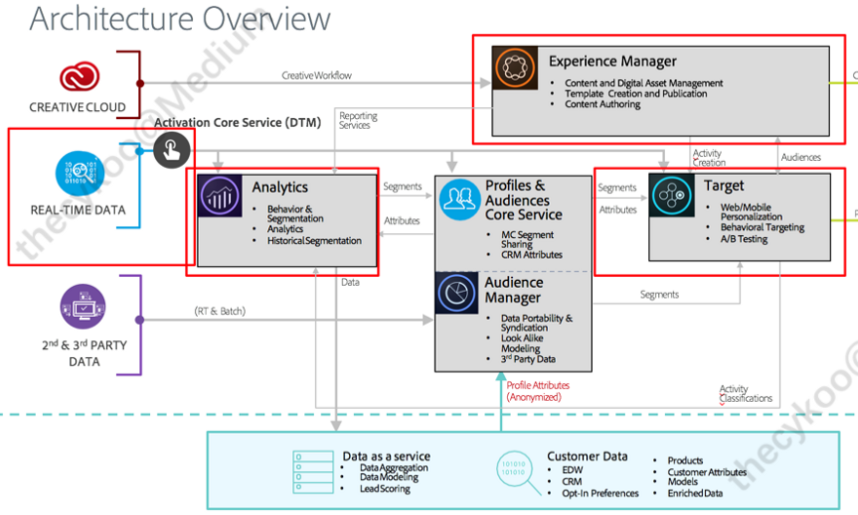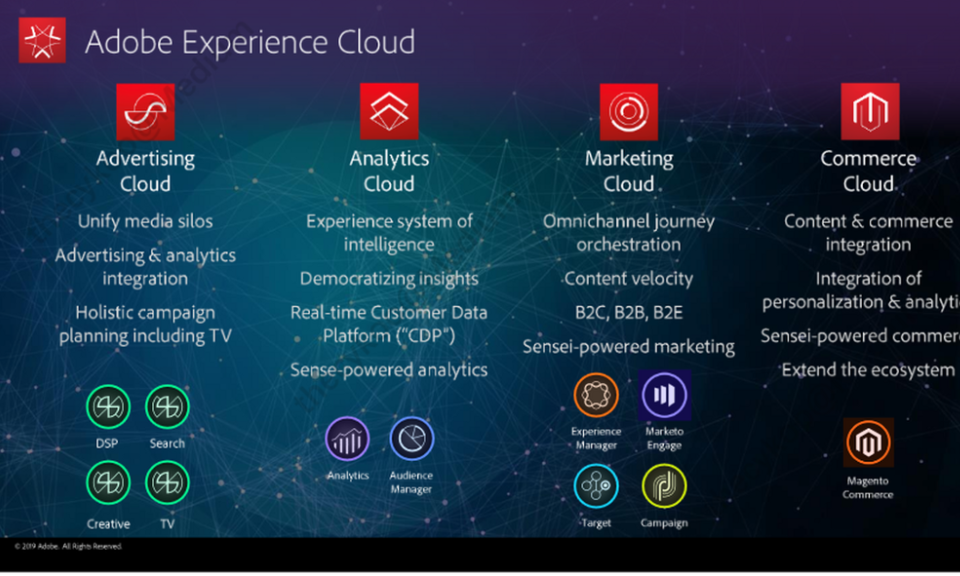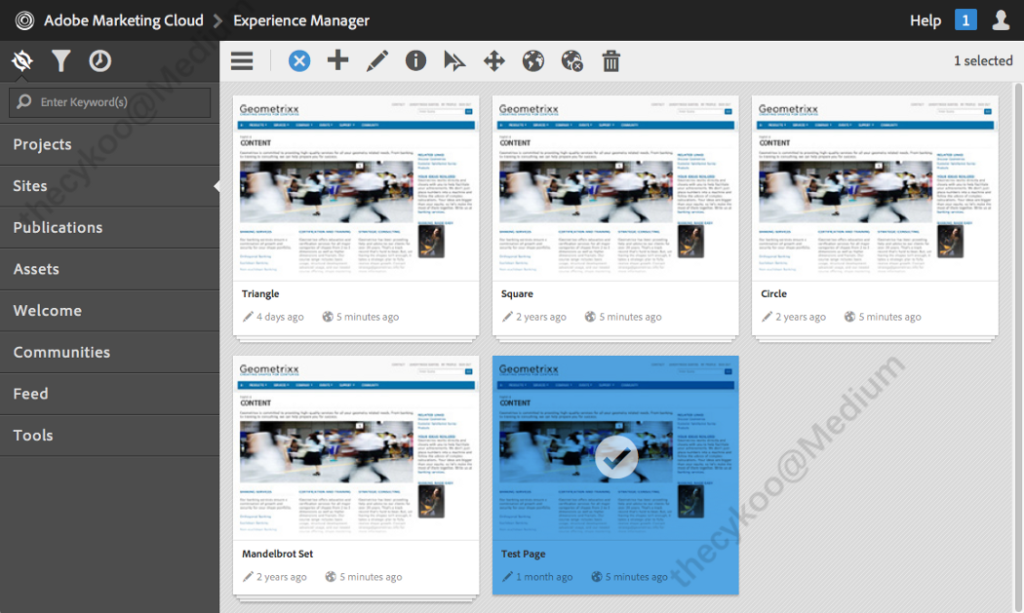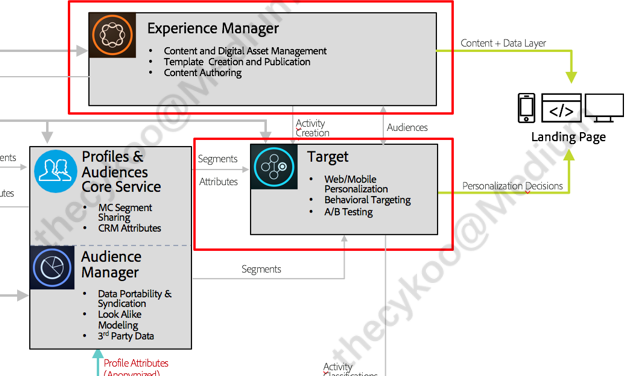
Why is Adobe so interested? How Experience Cloud is helping enterprises digitally transform
Adobe Experience Cloud, Content Management System (CMS), Digital Asset Management (DAM), Personalized Marketing, Website Analytics
1 April 2022
Many people associate Adobe with PDFs, followed by Adobe Photoshop, After Effects, and even the archaic Adobe Flash, all of which have had a significant impact on society. Adobe has aggressively expanded its cloud business in recent years, primarily by developing cloud marketing software and launching Adobe Experience Cloud (AEC) (formerly: Adobe Marketing Cloud (AMC)).
But, when it comes to marketing software, you might think that “under the impact of the COVID-19 epidemic, economic activity has shrunk significantly, major companies have reduced advertising activities, and Adobe, which primarily develops marketing software, must have been greatly affected,” right (according to 2016 data, Marketing Cloud accounted for approximately 30% of Adobe’s revenue)? This is completely incorrect. Adobe revenue growth remained strong, increasing 19% in the first quarter of 2020, with cloud and subscription services driving up gross margins once again.
Do you want to know what’s on the line for Adobe’s cloud services? Here’s a quick overview of Adobe Experience Cloud (AEC) and how it can help businesses around the world transform digitally.
 這是很重要的AEC架構圖 — Adobe Experience Cloud Architecture (Reference: Adobe Help)
這是很重要的AEC架構圖 — Adobe Experience Cloud Architecture (Reference: Adobe Help)
How Adobe is helping businesses digitally transform
Marketing places a premium on the customer experience and necessitates data analysis, advertising, marketing, and business services. But most businesses aren’t tech companies, and while they may do well with offline sales and have a large customer base, there’s no way to get started online.
Adobe is integrating the solutions required for several major aspects of marketing into the cloud platform Adobe Experience Cloud, resulting in an integrated solution to improve the customer experience and increase the opportunities for customers to use the company’s services. Adobe Experience Cloud is divided into 4 major components:
- Digital Marketing:Marketing Cloud
- AD Impression:Advertisements Cloud
- Data Analytics:Analytics Cloud
- Business Services:Commerce Cloud
 Adobe Experience Cloud (Reference: Adobe)
Adobe Experience Cloud (Reference: Adobe)
Marketing Cloud
Provide integrated digital marketing solutions to help enterprises personalize, optimize and manage customers’ digital experiences, increase customer engagement, and strengthen contact with customers.
The first step in digital marketing for businesses is to create an online sales channel. Many businesses choose to create their own web pages and then set up online stores that provide product information and sales methods. To begin with, establishing online channels is already a difficult task for businesses. Because a large sum of money is required to earn money in order to purchase infrastructure such as servers, and it is also necessary to recruit people in order to build an IT team. And, in most cases, the marketing team does not comprehend IT, and the IT team does not comprehend marketing… As a result, a process must be established internally through departmental communication, and marketing ideas must be posted on the IT web page.
Adobe Marketing Cloud products include Adobe Experience Manager (below), which provides a simple way to manage a website, even if the marketing team lacks extensive IT knowledge. When used in conjunction with all-in-one software such as Adobe Campaign, teams can quickly launch various marketing campaigns and monitor campaign data in real time.
 Adobe Experience Manager (Reference: Adobe)
Adobe Experience Manager (Reference: Adobe)
Analytics Cloud
In this day and age, every business is discussing data. Data services are an important part of Adobe’s offering, as shown in the architecture diagram at the beginning of the article.
Analytics Cloud is an intelligence engine provided by Adobe that integrates data from marketing channels to provide real-time data analytics in the Adobe Analytics management platform. Companies can also use marketing data to learn about different users’ habits and backgrounds, and then segment different customer groups in Adobe Audience Manager to provide a more personalized and customer-friendly user experience.
How to use data:
For example, it was discovered in marketing data that the majority of customers came from 1) search software and 2) travel websites (e.g. websites that searched for airline tickets). Companies can divide their customer base into three categories in Adobe Audience Manager: 1) ordinary customers, 2) customers interested in travel, and 3) customers who order travel-related products in Adobe Target/Experience Manager.
 根據客戶群提供個人化的用戶體驗(Reference: Adobe Help)
根據客戶群提供個人化的用戶體驗(Reference: Adobe Help)
Other possible applications include:
- Increase advertisements efficiency: Concentrate your advertisements on your intended audience.
- Customer requirements Analysis: Observe the source of the customer to analyze the customer’s needs
- Personalization: Distribute various pieces of information to various customers.
Advertising Cloud and Commerce Cloud
Advertising and commercial services are the last two sections of Adobe Experience Cloud. Adobe simplifies cross-channel and cross-screen video advertising across a variety of advertising platforms, including traditional TV and digital advertising, by providing services such as display and search ads.
Adobe has created a Common Cloud platform to assist in the creation of advertising content and the development of a promotion pro.
Of course, with the above-mentioned integrated Marketing Cloud and Analytics Cloud, we can use data and marketing aspects to improve the effectiveness of advertising.


